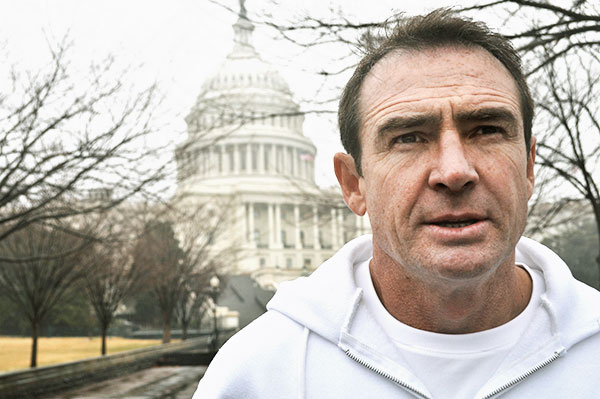On a normal morning, Pat Farmer wakes up in Sydney, Australia, after four hours of sleep and hits the ground running—literally. “I need to get a marathon in every single day just for peace of mind,” he says.
Here in Washington, as passersby hustle to work to escape the morning’s wintry mix, Farmer runs for an hour around the Mall and finishes the rest of his 26-mile-a-day regimen that afternoon.
Farmer was the first person to run vertically up and down Sydney’s AMP Tower in 24 hours (equivalent to running up Mount Everest in the same time), and he ran across the United States in 64 days. It’s probably safe to say that this 48-year-old might just be the fittest man alive.
But this year, the multiple world-record holder will take on his biggest challenge yet: From March 2011 to February 2012, Farmer will run 13,049 miles from the North to the South pole. That’s three continents, 14 countries, and two marathons a day on just fours hours of sleep.
“Nobody has ever backed up this sort of mileage day after day for such an extended period of time,” Farmer says. “Nobody on the face of the earth has ever done that.”
Then why do it?
To raise money for a cause, of course. Farmer’s idea to run from pole to pole began after visiting developing countries such as Thailand, Timor, and Vietnam, where he found children in hospitals and orphanages that lacked clean water. He learned that more than a million children die each year due to dehydration and malnutrition.
Now years in the making, the Pole to Pole Run will attempt to raise $100 million to deliver clean water and sanitation programs to these countries through the Australian Red Cross.
“I’m like a lot of people here in America who have a comfortable life, where we turn the water on and it comes out of the tap,” Farmer says. “We assume that the water is clean. We can buy new clothes. We can put a roof over our heads.”
But the majority of the world doesn’t have that luxury: “Two-thirds of the world’s population don’t have access to clean drinking water or sanitary conditions. This is basically a death sentence to those people.”
Farmer wants to use his “God-given gift” as a world-class runner to save lives. “This is not about putting a gold medal around my neck,” he says. “It’s about saying, ‘I’ve got a gift and I’m going to use that gift to support other people.’ ”
To train for the 11-month trek, Farmer treats his body “like a machine.” In preparation for the North Pole, he ran along Sydney’s beaches pulling truck tires to simulate dragging a kayak filled with his gear across ice. To acclimate to the weather, the below-freezing temperatures on the East Coast help—which is why he’s training in DC this week—though they’re nothing compared with the minus-40-degree temperatures and 62-mile-per-hour winds expected in the poles.
“Those are the sort of things I just have to put up with,” says Farmer, who will celebrate his March 14 birthday while training in the Arctic.
There’s more to his training than just running, however. On his journey, Farmer will burn approximately 12,000 calories a day (the average person burns 1,000 to 2,000). “Food and nutrition are absolutely vital,” he says. “If you put bad fuel into a car, you’re not going to get the top performance out of it.”
But Farmer’s “fuel” isn’t exactly mouthwatering: He’s been drinking “liters and liters” of olive oil for its high-caloric value. While fattening, it’s healthier than eating high amounts of animal fat, he says. In addition, it won’t freeze in the North or South Pole. “You can take a bar of chocolate with you, but you’ll bust your tooth trying to eat it,” Farmer says.
Throughout his five-stage journey (Arctic, Canada to Panama, Darien Jungle, South America, Antarctica) a team will accompany him to ensure his health and safety. A physiotherapist will “take this broken body and repair it as best as possible so that I can hit the road the next morning.” A doctor from the Australia Institute of Sport will monitor Farmer (“I’ll function as a human guinea pig,” he says) to see how a human body responds to the most extreme conditions on earth.
At times, it’s baffling how Farmer talks about this epic run as if he’s about to buy a new pair of shoes. While he knows it won’t be easy, he’s not worried about what injuries he may suffer or whether he’ll survive Panama’s dangerous Darien Jungle.
What he is concerned about is being a good example to his kids—he’s a single father of two—and inspiring more people to join the cause. Whether that’s by motivating people to hit the gym or helping them understand the need for clean water, he hopes the world will follow his run to save lives: “I want people to share this journey with me, and I want people to make this cause their own. This is not about one man’s journey; it’s about every man’s journey.”
Subscribe to Washingtonian More >> Health | Top Doctors | Well+Being Blog
Follow Well+Being on Twitter


















